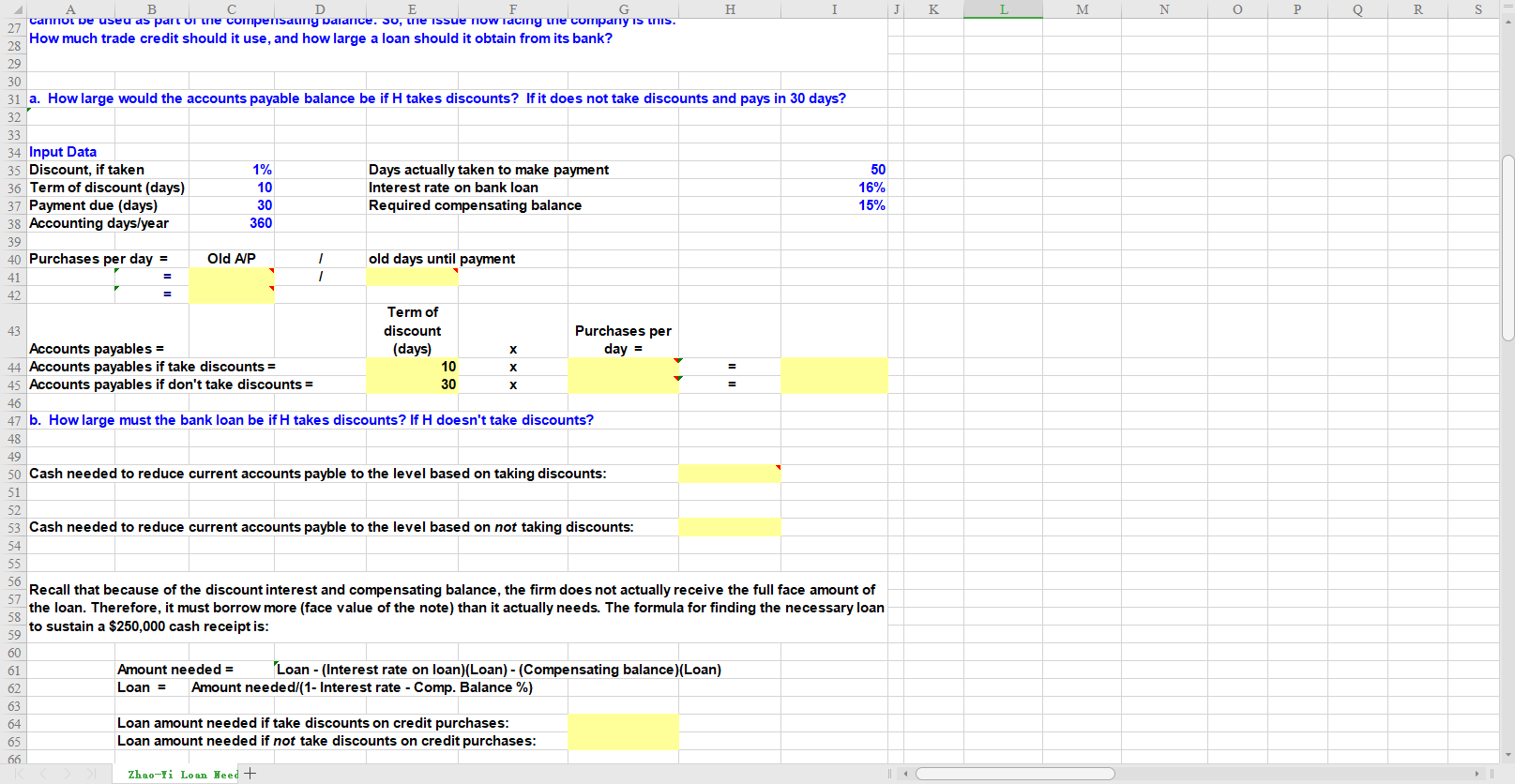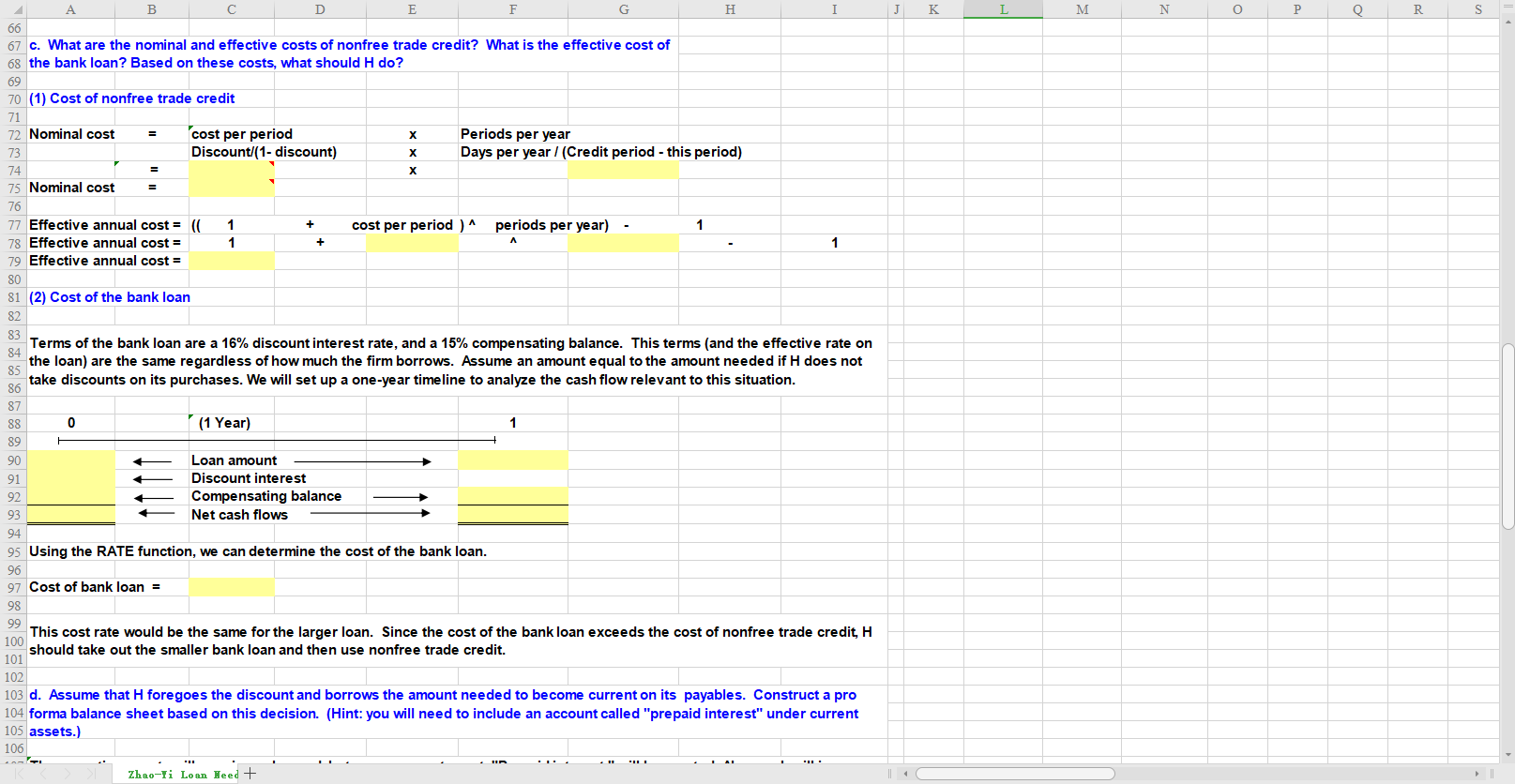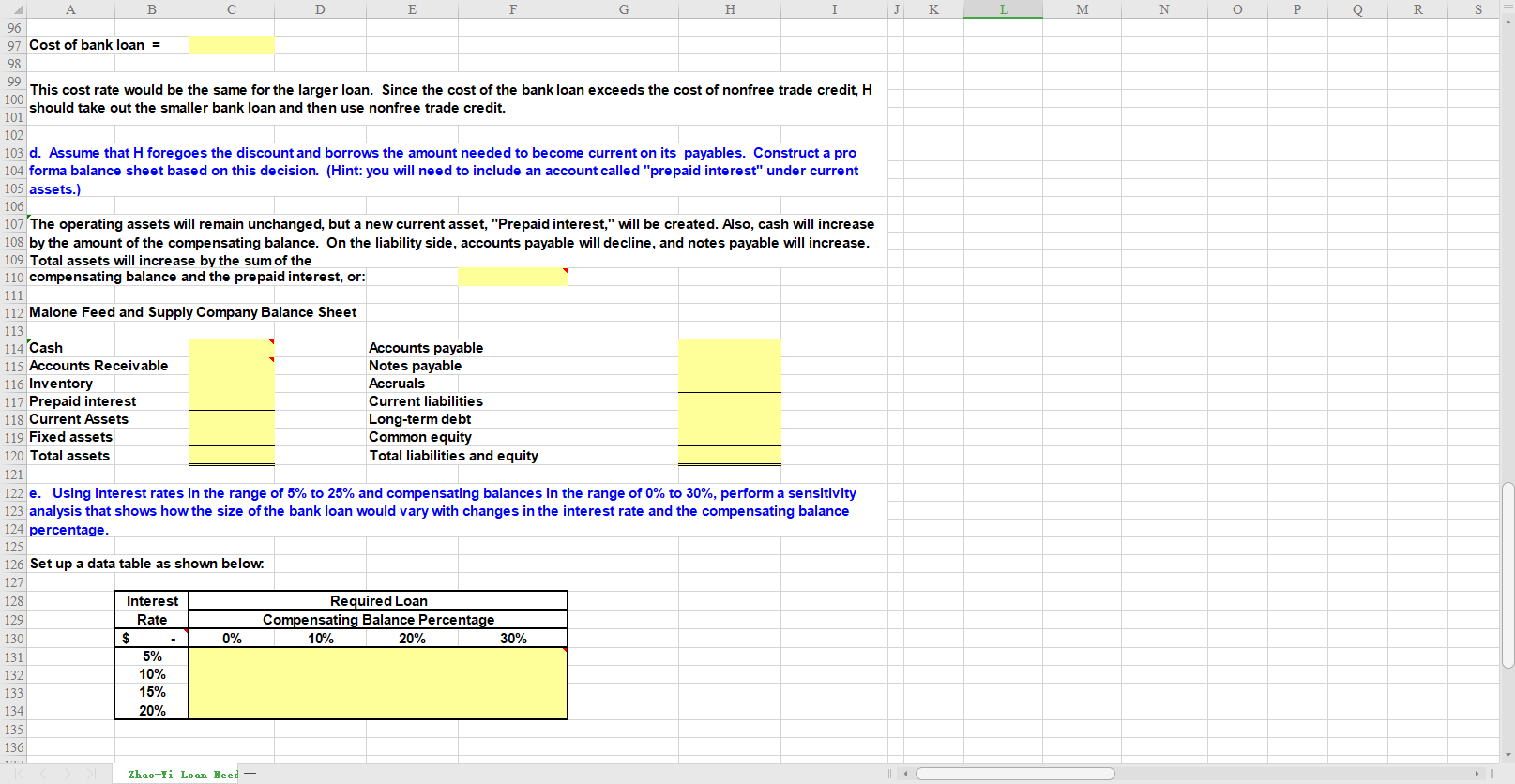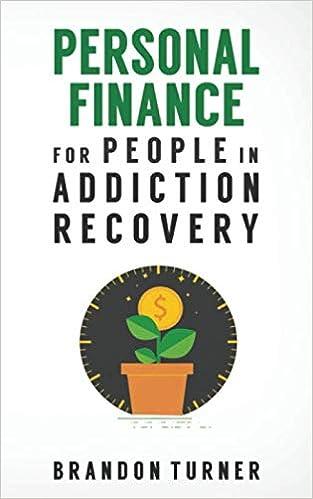



B D E K L M N O P Q R S 5 Fill out all beige blocks. 6 O 7 H Manufacturing buys on terms of 2/10, net 30, but it has not been paying on time--it is a "slower payer," and its suppliers are 8 getting upset. H does not take discounts, and it has been paying in 50 rather than the required 30 days. Assume that the 9 accounts payable are recorded at full cost, not net of discounts. H's balance sheet follows: 10 11 12 Cash $250,000 Accounts payable $2,500,000 13 Accounts Receivable 2,250,000 Notes payable 250,000 14 Inventory 3,750,000 Accruals 250,000 15 Current Assets 6,250,000 Current liabilities 3,000,000 16 Fixed assets 3,750,000 Long-term debt 750,000 17 Common equity 6,250,000 18 Total assets $10,000,000 Total liabilities and equity $10,000,000 19 20 21 H's suppliers are fed up and will not continue selling to H unless H begins making prompt payments (that is, paying in 30 days or 22 less). The firm is going to have to reduce its level of accounts payable, either to an amount that is equal to 30 days purchases (if it does not take discounts) or to 10 days purchases (if it decides to take discounts). Management has decided to obtain the needed funds by borrowing on an additional 1-year note payable (call this a current liability) from its bank at a rate of 16%, discount interest, with a 15% compensating balance required. The cash currently held by H is needed for transactions, so it 26 cannot be used as part of the compensating balance. So, the issue now facing the company is this: How much trade credit should it use, and how large a loan should it obtain from its bank? 28 29 30 31 a. How large would the accounts payable balance be if H takes discounts? If it does not take discounts and pays in 30 days? 32 33 34 Input Data 35 Discount, if taken 1% Days actually taken to make payment 50 36 Term of discount (days) 10 Interest rate on bank loan 16% 37 Payment due (days) 30 Required compensating balance 15% 38 Accounting days/year 360 39 40 Purchases per day = Old A/P old days until payment 41 42 Term of discount Purchases per Accounts payables = (davs! dav = Zhao-Ti Loan leed + 43 K L M N O P Q R S A B D E F G 27 cannot be useu as part of me compensauny walance. Ju, te issue now lacing the company is mis. How much trade credit should it use, and how large a loan should it obtain from its bank? 29 30 = 31 a. How large would the accounts payable balance be if H takes discounts? If it does not take discounts and pays in 30 days? 32 33 34 Input Data 35 Discount, if taken 1% Days actually taken to make payment 50 36 Term of discount (days) 10 Interest rate on bank loan 16% 37 Payment due (days) 30 Required compensating balance 15% 38 Accounting days/year 360 39 40 Purchases per day = Old A/P old days until payment 41 42 Term of 43 discount Purchases per Accounts payables = (days) day = 44 Accounts payables if take discounts = 10 45 Accounts payables if don't take discounts = 30 X 46 47 b. How large must the bank loan be if H takes discounts? If H doesn't take discounts? 48 49 50 Cash needed to reduce current accounts payble to the level based on taking discounts: 51 52 53 Cash needed to reduce current accounts payble to the level based on not taking discounts: 54 55 Recall that because of the discount interest and compensating balance, the firm does not actually receive the full face amount of 57 the loan. Therefore, it must borrow more (face value of the note) than it actually needs. The formula for finding the necessary loan 58 to sustain a $250,000 cash receipt is: 59 X 60 61 62 Amount needed = Loan - (Interest rate on loan)(Loan) - (Compensating balance)(Loan) Loan = Amount needed/(1- Interest rate - Comp. Balance %) 63 64 65 66 Loan amount needed if take discounts on credit purchases: Loan amount needed if not take discounts on credit purchases: Zhao-Ti Loan leed + J K L M N O P Q R S = 1 1 + A B D E F G H I 66 67 c. What are the nominal and effective costs of nonfree trade credit? What is the effective cost of 68 the bank loan? Based on these costs, what should H do? 69 70 (1) Cost of nonfree trade credit 71 72 Nominal cost cost per period X Periods per year 73 Discount/(1-discount) X Days per year / (Credit period - this period) 74 75 Nominal cost 76 77 Effective annual cost = (( cost per period ) periods per year) 78 Effective annual cost = 1 1 79 Effective annual cost = 80 81 (2) Cost of the bank loan 82 83 Terms of the bank loan are a 16% discount interest rate, and a 15% compensating balance. This terms (and the effective rate on 84 the loan) are the same regardless of how much the firm borrows. Assume an amount equal to the amount needed if H does not 85 take discounts on its purchases. We will set up a one-year timeline to analyze the cash flow relevant to this situation. 86 87 88 0 (1 Year) 89 90 Loan amount 91 Discount interest 92 Compensating balance 93 Net cash flows 94 95 Using the RATE function, we can determine the cost of the bank loan. 96 97 Cost of bank loan = 98 99 This cost rate would be the same for the larger loan. Since the cost of the bank loan exceeds the cost of nonfree trade credit, H 100 should take out the smaller bank loan and then use nonfree trade credit. 101 102 103 d. Assume that I foregoes the discount and borrows the amount needed to become current on its payables. Construct a pro 104 forma balance sheet based on this decision. (Hint: you will need to include an account called "prepaid interest" under current 105 assets.) 106 1 Zhao-Ii Loan Heed + K L M N O P Q R S D E F G H I 96 97 Cost of bank loan = 98 99 This cost rate would be the same for the larger loan. Since the cost of the bank loan exceeds the cost of nonfree trade credit H 100 should take out the smaller bank loan and then use nonfree trade credit. 101 102 103 d. Assume that I foregoes the discount and borrows the amount needed to become current on its payables. Construct a pro 104 forma balance sheet based on this decision. (Hint: you will need to include an account called "prepaid interest" under current 105 assets.) 106 107 The operating assets will remain unchanged, but a new current asset, "Prepaid interest," will be created. Also, cash will increase 108 by the amount of the compensating balance. On the liability side, accounts payable will decline, and notes payable will increase. 109 Total assets will increase by the sum of the 110 compensating balance and the prepaid interest, or: 111 112 Malone Feed and Supply Company Balance Sheet 113 114 Cash Accounts payable 115 Accounts Receivable Notes payable 116 Inventory Accruals 117 Prepaid interest Current liabilities 118 Current Assets Long-term debt 119 Fixed assets Common equity 120 Total assets Total liabilities and equity 121 122 e. Using interest rates in the range of 5% to 25% and compensating balances in the range of 0% to 30%, perform a sensitivity 123 analysis that shows how the size of the bank loan would vary with changes in the interest rate and the compensating balance 124 percentage. 125 126 Set up a data table as shown below. 127 128 Interest Required Loan 129 Rate Compensating Balance Percentage 130 $ 0% 10% 20% 30% 131 5% 132 10% 133 15% 134 20% 135 136 Zhao-Ti Loan leed + B D E K L M N O P Q R S 5 Fill out all beige blocks. 6 O 7 H Manufacturing buys on terms of 2/10, net 30, but it has not been paying on time--it is a "slower payer," and its suppliers are 8 getting upset. H does not take discounts, and it has been paying in 50 rather than the required 30 days. Assume that the 9 accounts payable are recorded at full cost, not net of discounts. H's balance sheet follows: 10 11 12 Cash $250,000 Accounts payable $2,500,000 13 Accounts Receivable 2,250,000 Notes payable 250,000 14 Inventory 3,750,000 Accruals 250,000 15 Current Assets 6,250,000 Current liabilities 3,000,000 16 Fixed assets 3,750,000 Long-term debt 750,000 17 Common equity 6,250,000 18 Total assets $10,000,000 Total liabilities and equity $10,000,000 19 20 21 H's suppliers are fed up and will not continue selling to H unless H begins making prompt payments (that is, paying in 30 days or 22 less). The firm is going to have to reduce its level of accounts payable, either to an amount that is equal to 30 days purchases (if it does not take discounts) or to 10 days purchases (if it decides to take discounts). Management has decided to obtain the needed funds by borrowing on an additional 1-year note payable (call this a current liability) from its bank at a rate of 16%, discount interest, with a 15% compensating balance required. The cash currently held by H is needed for transactions, so it 26 cannot be used as part of the compensating balance. So, the issue now facing the company is this: How much trade credit should it use, and how large a loan should it obtain from its bank? 28 29 30 31 a. How large would the accounts payable balance be if H takes discounts? If it does not take discounts and pays in 30 days? 32 33 34 Input Data 35 Discount, if taken 1% Days actually taken to make payment 50 36 Term of discount (days) 10 Interest rate on bank loan 16% 37 Payment due (days) 30 Required compensating balance 15% 38 Accounting days/year 360 39 40 Purchases per day = Old A/P old days until payment 41 42 Term of discount Purchases per Accounts payables = (davs! dav = Zhao-Ti Loan leed + 43 K L M N O P Q R S A B D E F G 27 cannot be useu as part of me compensauny walance. Ju, te issue now lacing the company is mis. How much trade credit should it use, and how large a loan should it obtain from its bank? 29 30 = 31 a. How large would the accounts payable balance be if H takes discounts? If it does not take discounts and pays in 30 days? 32 33 34 Input Data 35 Discount, if taken 1% Days actually taken to make payment 50 36 Term of discount (days) 10 Interest rate on bank loan 16% 37 Payment due (days) 30 Required compensating balance 15% 38 Accounting days/year 360 39 40 Purchases per day = Old A/P old days until payment 41 42 Term of 43 discount Purchases per Accounts payables = (days) day = 44 Accounts payables if take discounts = 10 45 Accounts payables if don't take discounts = 30 X 46 47 b. How large must the bank loan be if H takes discounts? If H doesn't take discounts? 48 49 50 Cash needed to reduce current accounts payble to the level based on taking discounts: 51 52 53 Cash needed to reduce current accounts payble to the level based on not taking discounts: 54 55 Recall that because of the discount interest and compensating balance, the firm does not actually receive the full face amount of 57 the loan. Therefore, it must borrow more (face value of the note) than it actually needs. The formula for finding the necessary loan 58 to sustain a $250,000 cash receipt is: 59 X 60 61 62 Amount needed = Loan - (Interest rate on loan)(Loan) - (Compensating balance)(Loan) Loan = Amount needed/(1- Interest rate - Comp. Balance %) 63 64 65 66 Loan amount needed if take discounts on credit purchases: Loan amount needed if not take discounts on credit purchases: Zhao-Ti Loan leed + J K L M N O P Q R S = 1 1 + A B D E F G H I 66 67 c. What are the nominal and effective costs of nonfree trade credit? What is the effective cost of 68 the bank loan? Based on these costs, what should H do? 69 70 (1) Cost of nonfree trade credit 71 72 Nominal cost cost per period X Periods per year 73 Discount/(1-discount) X Days per year / (Credit period - this period) 74 75 Nominal cost 76 77 Effective annual cost = (( cost per period ) periods per year) 78 Effective annual cost = 1 1 79 Effective annual cost = 80 81 (2) Cost of the bank loan 82 83 Terms of the bank loan are a 16% discount interest rate, and a 15% compensating balance. This terms (and the effective rate on 84 the loan) are the same regardless of how much the firm borrows. Assume an amount equal to the amount needed if H does not 85 take discounts on its purchases. We will set up a one-year timeline to analyze the cash flow relevant to this situation. 86 87 88 0 (1 Year) 89 90 Loan amount 91 Discount interest 92 Compensating balance 93 Net cash flows 94 95 Using the RATE function, we can determine the cost of the bank loan. 96 97 Cost of bank loan = 98 99 This cost rate would be the same for the larger loan. Since the cost of the bank loan exceeds the cost of nonfree trade credit, H 100 should take out the smaller bank loan and then use nonfree trade credit. 101 102 103 d. Assume that I foregoes the discount and borrows the amount needed to become current on its payables. Construct a pro 104 forma balance sheet based on this decision. (Hint: you will need to include an account called "prepaid interest" under current 105 assets.) 106 1 Zhao-Ii Loan Heed + K L M N O P Q R S D E F G H I 96 97 Cost of bank loan = 98 99 This cost rate would be the same for the larger loan. Since the cost of the bank loan exceeds the cost of nonfree trade credit H 100 should take out the smaller bank loan and then use nonfree trade credit. 101 102 103 d. Assume that I foregoes the discount and borrows the amount needed to become current on its payables. Construct a pro 104 forma balance sheet based on this decision. (Hint: you will need to include an account called "prepaid interest" under current 105 assets.) 106 107 The operating assets will remain unchanged, but a new current asset, "Prepaid interest," will be created. Also, cash will increase 108 by the amount of the compensating balance. On the liability side, accounts payable will decline, and notes payable will increase. 109 Total assets will increase by the sum of the 110 compensating balance and the prepaid interest, or: 111 112 Malone Feed and Supply Company Balance Sheet 113 114 Cash Accounts payable 115 Accounts Receivable Notes payable 116 Inventory Accruals 117 Prepaid interest Current liabilities 118 Current Assets Long-term debt 119 Fixed assets Common equity 120 Total assets Total liabilities and equity 121 122 e. Using interest rates in the range of 5% to 25% and compensating balances in the range of 0% to 30%, perform a sensitivity 123 analysis that shows how the size of the bank loan would vary with changes in the interest rate and the compensating balance 124 percentage. 125 126 Set up a data table as shown below. 127 128 Interest Required Loan 129 Rate Compensating Balance Percentage 130 $ 0% 10% 20% 30% 131 5% 132 10% 133 15% 134 20% 135 136 Zhao-Ti Loan leed +










